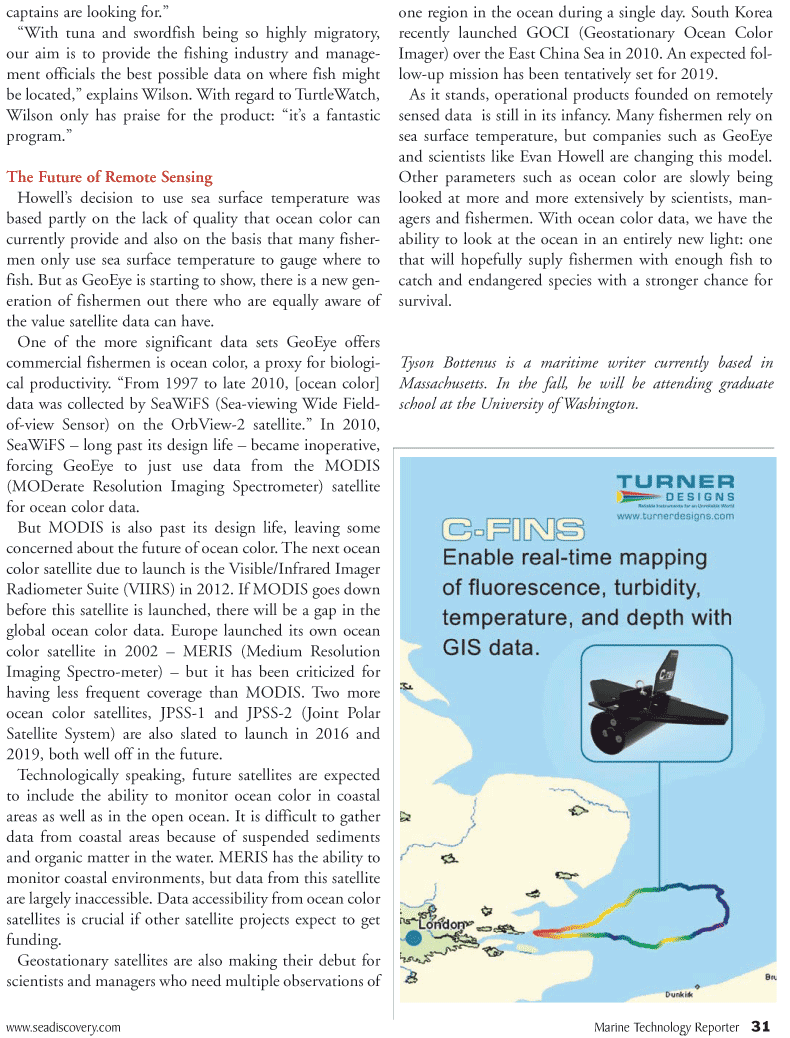
Page 31: of Marine Technology Magazine (June 2011)
Hydrographic Survey
Read this page in Pdf, Flash or Html5 edition of June 2011 Marine Technology Magazine
www.seadiscovery.com Marine Technology Reporter 31 captains are looking for.” “With tuna and swordfish being so highly migratory, our aim is to provide the fishing industry and manage- ment officials the best possible data on where fish might be located,” explains Wilson. With regard to TurtleWatch,
Wilson only has praise for the product: “it’s a fantastic program.”
The Future of Remote Sensing
Howell’s decision to use sea surface temperature was based partly on the lack of quality that ocean color can currently provide and also on the basis that many fisher- men only use sea surface temperature to gauge where to fish. But as GeoEye is starting to show, there is a new gen- eration of fishermen out there who are equally aware of the value satellite data can have.
One of the more significant data sets GeoEye offers commercial fishermen is ocean color, a proxy for biologi- cal productivity. “From 1997 to late 2010, [ocean color] data was collected by SeaWiFS (Sea-viewing Wide Field- of-view Sensor) on the OrbView-2 satellite.” In 2010,
SeaWiFS – long past its design life – became inoperative, forcing GeoEye to just use data from the MODIS (MODerate Resolution Imaging Spectrometer) satellite for ocean color data.
But MODIS is also past its design life, leaving some concerned about the future of ocean color. The next ocean color satellite due to launch is the Visible/Infrared Imager
Radiometer Suite (VIIRS) in 2012. If MODIS goes down before this satellite is launched, there will be a gap in the global ocean color data. Europe launched its own ocean color satellite in 2002 – MERIS (Medium Resolution
Imaging Spectro-meter) – but it has been criticized for having less frequent coverage than MODIS. Two more ocean color satellites, JPSS-1 and JPSS-2 (Joint Polar
Satellite System) are also slated to launch in 2016 and 2019, both well off in the future.
Technologically speaking, future satellites are expected to include the ability to monitor ocean color in coastal areas as well as in the open ocean. It is difficult to gather data from coastal areas because of suspended sediments and organic matter in the water. MERIS has the ability to monitor coastal environments, but data from this satellite are largely inaccessible. Data accessibility from ocean color satellites is crucial if other satellite projects expect to get funding.
Geostationary satellites are also making their debut for scientists and managers who need multiple observations of one region in the ocean during a single day. South Korea recently launched GOCI (Geostationary Ocean Color
Imager) over the East China Sea in 2010. An expected fol- low-up mission has been tentatively set for 2019.
As it stands, operational products founded on remotely sensed data is still in its infancy. Many fishermen rely on sea surface temperature, but companies such as GeoEye and scientists like Evan Howell are changing this model.
Other parameters such as ocean color are slowly being looked at more and more extensively by scientists, man- agers and fishermen. With ocean color data, we have the ability to look at the ocean in an entirely new light: one that will hopefully suply fishermen with enough fish to catch and endangered species with a stronger chance for survival.
Tyson Bottenus is a maritime writer currently based in
Massachusetts. In the fall, he will be attending graduate school at the University of Washington.

 30
30

 32
32
